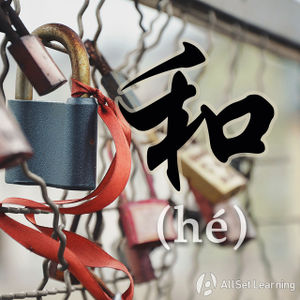Difference between revisions of "Expressing "and" with "he" (advanced)"
| Line 57: | Line 57: | ||
* [[Basic Patterns of Chinese Grammar]] (pp. 74-5) [http://www.amazon.com/gp/product/1933330899/ref=as_li_ss_tl?ie=UTF8&tag=allset-20&linkCode=as2&camp=217145&creative=399373&creativeASIN=1933330899 →buy] | * [[Basic Patterns of Chinese Grammar]] (pp. 74-5) [http://www.amazon.com/gp/product/1933330899/ref=as_li_ss_tl?ie=UTF8&tag=allset-20&linkCode=as2&camp=217145&creative=399373&creativeASIN=1933330899 →buy] | ||
* [[Chinese: An Essential Grammar, Second Edition]] (pp. 14-5) [http://www.amazon.com/gp/product/0415372615/ref=as_li_ss_tl?ie=UTF8&tag=allset-20&linkCode=as2&camp=217145&creative=399369&creativeASIN=0415372615 →buy] | * [[Chinese: An Essential Grammar, Second Edition]] (pp. 14-5) [http://www.amazon.com/gp/product/0415372615/ref=as_li_ss_tl?ie=UTF8&tag=allset-20&linkCode=as2&camp=217145&creative=399369&creativeASIN=0415372615 →buy] | ||
| + | * [[现代汉语虚词例释]] (p. 236)[http://www.amazon.cn/%E7%8E%B0%E4%BB%A3%E6%B1%89%E8%AF%AD%E5%85%AB%E7%99%BE%E8%AF%8D/dp/B004323J90/ref=sr_1_1?ie=UTF8&qid=1345693275&sr=8-1 →buy] | ||
| + | * [[现代汉语八百词]] p.265 [http://www.amazon.cn/mn/detailApp?_encoding=UTF8&tag=allset-23&linkCode=as2&asin=B001198GSW&camp=536&creative=3132&creativeASIN=B001198GSW →buy] | ||
| + | * [[实用现代汉语语法]](p.317)[http://www.amazon.cn/mn/detailApp?_encoding=UTF8&tag=allset-23&linkCode=as2&asin=B003YJGCSS&camp=536&creative=3132&creativeASIN=B003YJGCSS →buy] | ||
=== Websites === | === Websites === | ||
Revision as of 03:01, 6 March 2015
| This article is a stub. Editors can help the Chinese Grammar Wiki by expanding it. |
-
Level
-
Similar to
-
Used for
-
Keywords
You probably learned early on that 和 (hé) is used to connect nouns and noun phrases not mean "and," but not sentences. This rule is fine for a while but eventually you will begin encountering what appears to be non-nouns linked by 和. This article addresses when it's grammatically correct to use 和 in other ways.
Contents
Linking Verbs with 和
Verb1 + 和 + Verb2
大多数情况下,由“和”连接的两个动词具有如下特点:
- 是同类词。这里“同类”的意思是指这两个动词所指相似,表述范围基本一致。这是为什么“唱歌和跳舞”听起来是自然的,但是“玩游戏和跑”就很别扭。
- 是双音节动词。
- 两个动词都有一个共同的修饰成分或者有一个共同的宾语。
- 政府 每年 都 会 维护 和 修理 这些 建筑 。
- 我们 需要 进一步 地 了解 和 交流。
- 他 十八岁 的 时候 就 管理 和 运营 着 一 家 公司。
- 这 种 材料 可以 无限 地 回收 和 利用。
- 预防 和 治理 污染 需要 所有 人 共同 的 努力。
Linking Adjectives with 和
Adj1 + 和 + Adj2
大多数情况下,由“和”连接的两个形容词具有如下特点:
- 在句中不做谓语,而是做其他句子成分,比如:宾语、定语等。
- 形容词前面都有修饰成分。
- 我 就是 喜欢 她 任性 和 调皮,怎么了?(做宾语)
- 她 那么 单纯 和 天真,你 怎么 可以 这样 对 她?(有修饰成分)
- 她 安静 和 甜美 的笑容让我觉得温暖。(做定语)
- 这种 恐惧 和 担心 不 是 没有 道理。(有修饰成分,做主语)
- 你 什么时候 才 可以 像 他 那样 冷静 和 理性?(有修饰成分)
See also
- Expressing "in addition" with "haiyou"
- "In addition" as "lingwai"
- Expressing "not only… but also"
- Combining verbs with "bing"
Sources and further reading
Books
- Basic Patterns of Chinese Grammar (pp. 74-5) →buy
- Chinese: An Essential Grammar, Second Edition (pp. 14-5) →buy
- 现代汉语虚词例释 (p. 236)→buy
- 现代汉语八百词 p.265 →buy
- 实用现代汉语语法(p.317)→buy



